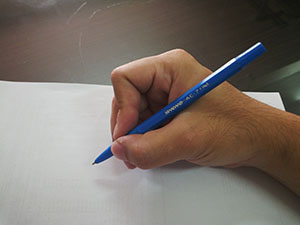Search the Community
Showing results for tags 'hand'.
-
Does anyone else notice that the quality and nature of penmanship changes depending on the nib, pen, ink, and paper?? Here's a sample of my sloppy handwriting. Practice in progress. Rhodia Paper.
-

Arthritis Hands. Etiquette Of Switching To Print As Needed?
kealani posted a topic in Handwriting & Handwriting Improvement
I occasionally have arthritis flare ups in my hands and fingers. With that, my normally "Business Palmer" cursive turns illegible. However, my printing is very legible and nicely spaced, but much slower than my cursive. It is enjoyable to me to write cursive and to slowly improve . . . .but. . ....- 17 replies
-
- handwriting
-
(and 7 more)
Tagged with:
-
Hello, Being a ballpoint generation and having used ballpoints since the first day I went to school, I had difficulty in transitioning to fountain pens. Loosening up the grip and using the whole arm movement were like learning how to walk all over again. In the end, I finally found what works for...
- 10 replies
-
- hold
- fountain pen
- (and 4 more)




